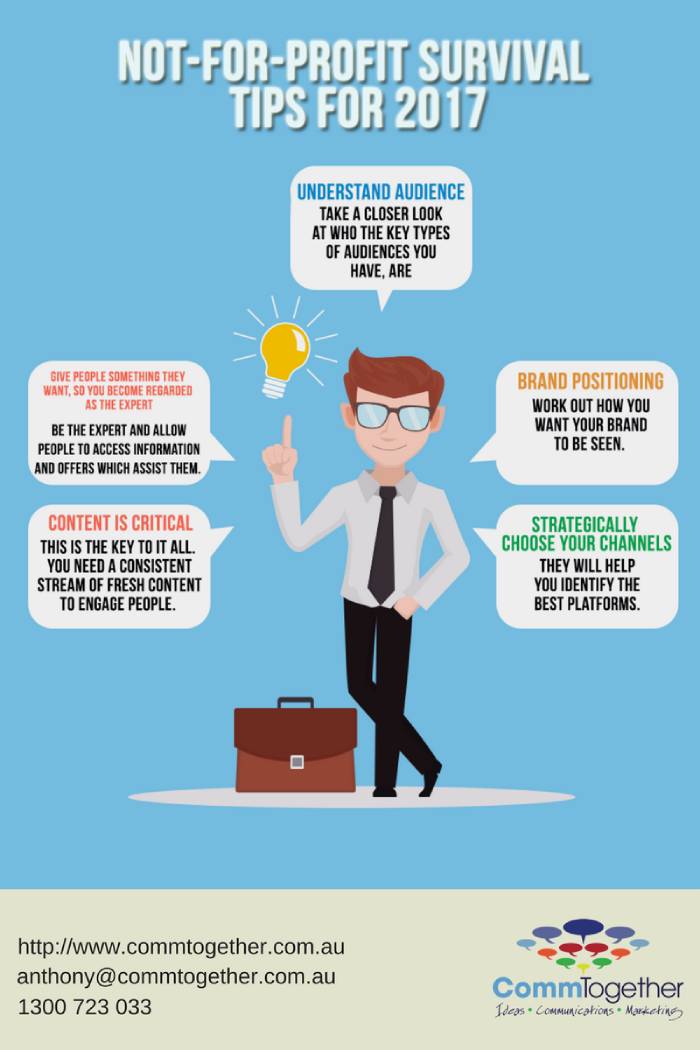
My not-for-profit survival tips for 2017 can be summed up in one word – ‘communications’. In particular, in 2017, you have to be part of the communications revolution. Any not-for-profit (including charities community groups and NGO’s) has a lot of moving parts to it and various things to consider, but they all boil down to communications, to ensure they will work correctly.
Communication is critical because with it people don’t know you exist. Equally, unless you engage with the audience, you don’t know what they want and where the opportunities lie. You need to convince them, by marketing to them the value of your offer, be it a product or service.
The communications revolution has been consistently gaining momentum since the internet came to life and everyone began accessing it from their pockets. You need to feed into it to survive. Do you know where you stand at the moment?
The following tips for not-for-profit survival in 2017 are critical communications fundamentals which no organisation, no matter the size, can afford to ignore.

1. Understand audience
Develop personas. Take a closer look at who the key types of audiences you have, are. Give them a name and put together as much detail as you can about them. Why? If you are having a dinner party with one friend today, you know the are certain subjects you’ll discuss because of shared interests and you will speak in a particular way (e.g. could be less formal depending on the friendship). You need to do the same for your not-for-profit.
2. Brand positioning
Work out how you want your brand to be seen. What language should it be using? Watch TV tonight and take note of the ads. How do these brands talk to you and how are they different? You don’t see someone in a suit selling the latest ute for a reason.
3. Strategically choose your channels
Most not-for-profits do not have the resources to be on all the types media channels (including social). Generally speaking, it is not necessary either, when you understand tips one and two. They will help you identify the best platforms. For example, Facebook may be best if your audience is more women 25-50, versus Twitter which is more male focused.
4. Content is critical
This is the key to it all. You need a consistent stream of fresh content to engage people. Add value, contribute and don’t make it all about what you are selling. Most organisations attribute large amounts of their clients to referrals. Referrals come from building relationships. Relationships are built on communications, finding common ground and making it a two-way process.
5. Give people something they want, so you become regarded as the expert
Be the expert and allow people to access information and offers which assist them. This is an extension of the relationship building process. You want them to think, “we’ll go with them because we like what they have had to say” and they had a chance to get to know them, even if it is through published works. Give and ye shall receive.
My bonus tip for not-for-profit survival in 2017…
This will ultimately be a kind of not-for-profit survival of the fittest, so invest in these communications! Whether it is your own time or through the use of internal or external resources. You need to be prepared to spend time and money on what is essentially an inbound marketing strategy. It is the buzz term, and it is very much the way to future proof your not-for-profit organisation.
Take a snapshot of where you are now. You want to be able to measure your improvement. You may want some help with a Communications Audit, which is designed to get you thinking about all components which make up these tips. It will focus you on what needs to be done. and give you a plan. Contact us if you want some assistance, as we have designed a thorough process with a personalised report to give you all you need.
If you are interested in pulling together a full content strategy and wondering how to go about it, then please download our free e-book. It contains all the information you need to get underway.
